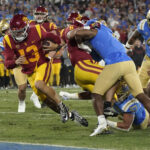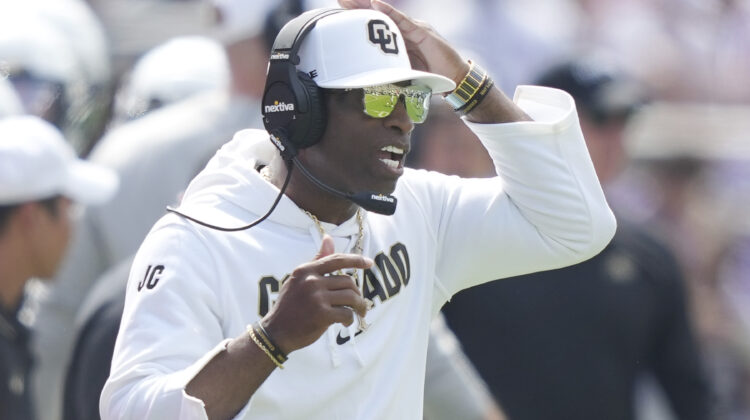Instant reaction to Pac-12 developments in Week 1 …
1. Stellar start
A catastrophic summer gave way to an idyllic weekend for the Pac-12 — at least thus far.
One team, Oregon State, has yet to take the field. But the other 11 are perfect through the first Saturday of the season.
The list of accomplishments includes the Colorado stunner at TCU, Utah thumping Florida, Washington’s blowout victory over Boise State and decisive road wins by Stanford, Cal and Washington State.
Put another way: For one weekend, the Pac-12 more than justified the offseason hype.
Not surprisingly, the powerhouse offenses across the conference carried the day — and they did so in historic fashion.
For the first time since at least 1980, five teams scored at least 50 points, according to STATS. Oregon (81), USC (66), Washington (56), Washington State (50) and Cal (58) — yes, Cal — all got halfway to 100.
If Oregon State takes care of business Sunday at San Jose State, the Pac-12 will be the only Power Five league without a non-conference loss.
And it will have recorded only its second perfect weekend, with a minimum of four games played, of the century. (The other instance: Week 1 of the 2017 season, per STATS.)
The conference cannot entirely escape the reality of its looming extinction, but there’s one way to keep some of the focus on football: The Pac-12 needs to dominate on the field.
Through the first of three vital non-conference Saturdays, it’s doing just that.
2. QBs sizzle
Not surprisingly, the quarterbacks led the way.
Yes, the returning starters were stellar. USC’s Caleb Williams, Washington’s Michael Penix, Oregon’s Bo Nix, Arizona’s Jayden de Laura and WSU’s Cam Ward produced 19 touchdowns and one interception as their teams racked up 291 points.
But they were hardly alone.
Colorado’s Shedeur Sanders threw for 510 yards and four touchdowns in his first game at the FBS level.
Cal backup Ben Finely replaced injured starter Sam Jackson and threw for 287 yards and a touchdown.
Stanford’s Ashton Daniels, who had six attempts to his name prior to this season, tossed two touchdowns and accumulated 290 yards (running and passing).
Meanwhile, freshman Arizona State Jaden Rashada justified coach Kenny Dillingham’s faith, deftly navigating his first start and a lengthy weather delay with 236 yards and two touchdowns.
Utah’s Bryson Barnes filled in for injured starter Cam Rising in the high-profile duel with Florida and managed the environment expertly.
It would have been difficult to script a better first Saturday for what has been billed as the best collection of quarterbacks in the country — and one of the most acclaimed groups in conference history.
3. A better bottom?
The preseason favorites (USC, Washington, Utah and Oregon) all looked the part against a varied group of opponents, but we had one eye on the teams that finished at the bottom of the conference last season.
Cal, Arizona State, Stanford and Colorado went 6-30 in league play. All except ASU looked an order of magnitude better. (The Sun Devils had an excellent excuse after the administration chose to self-impose a bowl ban and announced the decision five days prior to kickoff.)
We aren’t suggesting a berth in the conference championship game awaits the 2022 laggards. Heck, we aren’t convinced any of them will become bowl-eligible.
But they don’t have to reach .500 to impact the trajectory of the Pac-12’s season. In a zero-sum game, parity is the enemy of playoff berths and top-25 rankings. The better the bottom of the conference, the more arduous the path for the teams at the top.
4. Mountain climbs
Not all wins are created equal, and the most impressive of the bunch came courtesy of the Mountain schools: Colorado’s upset of TCU, and Utah’s smothering of Florida — the only two Power Five matchups on the Pac-12’s Week 1 schedule.
Every aspect of coach Deion Sanders’ debut was impressive, from his son, Shedeur, to tailback Dylan Edwards to two-way star Travis Hunter (receiver and cornerback). But the most significant development unfolded at scrimmage: CU’s offensive line was not awful.
In fact, it was downright respectable, despite all the personnel changes and the new playbook. (Offensive coordinator Sean Lewis is one of the best in the business.)
The Buffaloes won’t remain competitive over the next 12 weeks without solid line play. The cohesiveness on display Saturday suggests there’s a real chance of a consistent, quality front.
Over in Salt Lake City, all eyes were on the quarterback. With Cam Rising unavailable because of the knee injury sustained in the Rose Bow, Barnes stepped in and directed an efficient, dominating performance.
Now, to be clear: Florida is nowhere close to a top-tier opponent, but that matters little to the Utes. After back-to-back conference titles, they have designs on a playoff berth.
Which means they cannot lose more than one game.
Which means they’re in survival mode until Rising is not only healthy but in top form. And that process could take weeks.
5. An eye on Week 2
Mark Sept. 9 as the most significant day of the Pac-12’s non-conference season. So many marquee opponents are lined up — from morning until night, at home and on the road, across all major TV networks — that it’s worth mentioning here, before Week 1 is officially in the books.
The Pac-12 will face seven opponents from Power Five conferences: Auburn, Baylor, Mississippi State, Nebraska, Oklahoma State, Texas Tech and Wisconsin.
That daunting total takes on added weight given that Stanford and USC are set to collide in their usual Week 2 affair. Only 10 teams have non-conference dates, and seven are with Power Five foes.
We’ll have much more on the Sept. 9 matchups — and point spreads — in coming days. But after the collective showing this weekend, and with four of the seven marquee dates on Pac-12 turf, the bar for success is high.
*** Send suggestions, comments and tips (confidentiality guaranteed) to pac12hotline@bayareanewsgroup.com or call 408-920-5716
*** Follow me on Twitter: @WilnerHotline
*** Pac-12 Hotline is not endorsed or sponsored by the Pac-12 Conference, and the views expressed herein do not necessarily reflect the views of the Conference.
Related posts:
 VIDEO – Jon Wilner and Brad Cesmat chop-up session : Colorado bolting Pac-12, Arizona future, more…
VIDEO – Jon Wilner and Brad Cesmat chop-up session : Colorado bolting Pac-12, Arizona future, more…

(AP Photo/Darryl Webb)
Pac-12 survival: What’s next for Oregon State, Washington State, Stanford and Cal after mass exodus to Big Ten, Big 12
Southern California quarterback Caleb Williams (13) (AP Photo/Mark J. Terrill)
Pac-12 football preview: The top games each week in a schedule loaded with marquee matchups VIDEO Wilner and Cesmat Weekly Chop-Up. Pac-12 name value with CFP, Cal and Stanford move, more
VIDEO Wilner and Cesmat Weekly Chop-Up. Pac-12 name value with CFP, Cal and Stanford move, more


